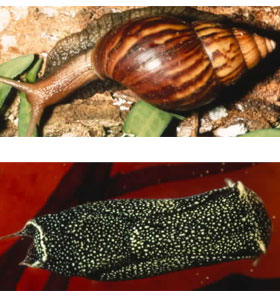Heterobranchia

|
|
|
# of Described Species: 30,000 or more First Appearance: Habitats: Marine, Freshwater, Brackish, and Terrestrial Shapes: Slugs, Limpets, and any other types of snails you can imagine Feeding Types: |
|

|
|
|
# of Described Species: 30,000 or more First Appearance: Habitats: Marine, Freshwater, Brackish, and Terrestrial Shapes: Slugs, Limpets, and any other types of snails you can imagine Feeding Types: |
|
|
Heterobranchia is a very large group that has only recently been recognized as a clade within
Gastropoda. Several marine and one freshwater group
(Valvatidae) that were previously included in the "Mesogastropoda" and two very large groups
previously given subclass status - the Opisthobranchia and Pulmonata (collectively the Euthyneura)
were found to be related lineages in a recent phylogenetic analysis. The more basal members
comprise about a dozen families that are mostly small-sized, poorly-known
operculate groups.
The opisthobranchs comprise about 25 families and 2000 species of the bubble shells (many families) and the seaslugs (many families) as well as the and sea hares (Aplysiidae). Virtually all opisthobranchs are marine with the majority showing shell reduction or shell loss and only some of the "primitive" shell-bearing taxa having an operculum as adults. This diverse group contains about 25 families and approximately 2000 species, many of these being nudibranch seaslugs. |
The pulmonates comprise the majority of land snails and slugs - a very diverse group comprising many families and about 20,000 species. A few marine pulmonates (including the limpet-shaped Siphonariidae) comprise groups that mostly inhabit estuaries. A basal group of mainly estuarine air breathing slugs (Onchidiidae) also has terrestrial relatives (Veronicellidae, Rathouisiidae). Some important groups of freshwater snails are also included here - the Lymnaeidae, Planorbidae, Physidae and Ancylidae. The operculum is absent in all pulmonates except the estuarine Amphibolidae and the freshwater Glacidorbidae. The shells of heterobranchs are never nacreous. |


